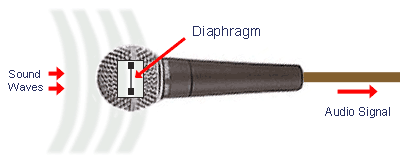How Do Microphones Work?
The Basics
Microphones are a type of transducer - a device which converts energy from one form to another. Microphones convert acoustical energy (sound waves) into electrical energy (the audio signal).
Different types of microphone have different ways of converting energy but they all share one thing in common: The diaphragm. This is a thin piece of material (such as paper, plastic or aluminium) which vibrates when it is struck by sound waves. In a typical hand-held mic like the one below, the diaphragm is located in the head of the microphone.
Location of Microphone Diaphragm

When the diaphragm vibrates, it causes other components in the microphone to vibrate. These vibrations are converted into an electrical current which becomes the audio signal.
Note: At the other end of the audio chain, the loudspeaker is also a transducer - it converts the electrical energy back into acoustical energy.
Types of Microphone
There are a number of different types of microphone in common use. The differences can be divided into two areas:
(1) The type of conversion technology they use
This refers to the technical method the mic uses to convert sound into electricity. The most common technologies are dynamic, condenser, ribbon and crystal. Each has advantages and disadvantages, and each is generally more suited to certain types of application. The following pages will provide details.
(2) The type of application they are designed for
Some mics are designed for general use and can be used effectively in many different situations. Others are very specialised and are only really useful for their intended purpose. Characteristics to look for include directional properties, frequency response and impedance (more on these later).
Mic Level & Line Level
The electrical current generated by a microphone is very small. Referred to as mic level, this signal is typically measured in millivolts. Before it can be used for anything serious the signal needs to be amplified, usually to line level (typically 0.5 -2V). Being a stronger and more robust signal, line level is the standard signal strength used by audio processing equipment and common domestic equipment such as CD players, tape machines, VCRs, etc.
This amplification is achieved in one or more of the following ways:
- Some microphones have tiny built-in amplifiers which boost the signal to a high mic level or line level.
- The mic can be fed through a small boosting amplifier, often called a line amp.
- Sound mixers have small amplifiers in each channel. Attenuators can accommodate mics of varying levels and adjust them all to an even line level.
- The audio signal is fed to a power amplifier - a specialised amp which boosts the signal enough to be fed to loudspeakers.
Next Page: Dynamic Microphones